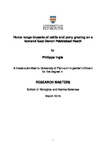Home range impacts of cattle and pony grazing on a lowland east Devon Pebblebed Heath
| dc.contributor.supervisor | Intachat, Jurie | |
| dc.contributor.author | Ingle, Philippa | |
| dc.contributor.other | School of Biological and Marine Sciences | en_US |
| dc.date.accessioned | 2019-03-29T15:43:56Z | |
| dc.date.available | 2019-03-29T15:43:56Z | |
| dc.date.issued | 2019 | |
| dc.date.issued | 2019 | |
| dc.identifier | 746543 | en_US |
| dc.identifier.uri | http://hdl.handle.net/10026.1/13582 | |
| dc.description.abstract |
Home range impacts of cattle and pony grazing on a lowland East Devon Pebblebed Heath by Philippa Ingle Lowland heath is of ecological importance due to the rarity of the habitats and of the species supported. Bicton Common is an East Devon lowland Pebblebed heath comprised of Atlantic wet heath, dry heath and mire, of which the former two are both Annex I habitats. Both the wet heath and mire are in favourable recovery whereas, the dry heath is in unfavourable recovery partly due to the dominance of M. caerulea. The main aim of this study was to assess the impact of grazing after two seasons on the three types of habitats in relation to two control sites: dry heath and a mosaic habitat. This was achieved by the construction of a robust methodological protocol, which was successfully used to collect vegetative data within this short term study. Secondly, the baseline vegetative conditions of the five sites were investigated. This was achieved by comparing the vegetative data with the existing NVC floristic tables. It was found that the wet heath and the dry heath within both the non-control and control sites were typical NVC habitats whereas, the mire displayed non-typical characteristics. Unsurprisingly, the mosaic habitat displayed characteristics of both the dry heath and wet heath habitats. Finally, GPS collars were used on one cow and one pony in order to collect data that was used to identify home ranges (HRs), habitat preferences and grazing behaviour. A semi-structured interview was also carried out to validate the results. It was found that the cow had 18 HRs in contrast to the pony that only had four. There were a greater number of GPS points recorded within the dry heath and wet heath, relative to the mire, by types of animal. Additionally, both the cow and pony used the tracks to commute and graze. The results of this study indicate that grazing did contribute to a number of changes within the vegetation: a decrease in the percentage cover of E. angustifolium and C. vulgaris; an increase in percentage cover of U. gallii, E. cinerea and M. caerulea; a decrease in the biodiversity of both the dry and wet heath; an increase in the biodiversity of the mire. | en_US |
| dc.language.iso | en | |
| dc.publisher | University of Plymouth | |
| dc.subject | Grazing | |
| dc.subject | GPS | |
| dc.subject | Home Ranges | |
| dc.subject | Biodiversity | |
| dc.subject | Lowland heath | en_US |
| dc.subject.classification | ResM | en_US |
| dc.title | Home range impacts of cattle and pony grazing on a lowland east Devon Pebblebed Heath | en_US |
| dc.type | Thesis | |
| plymouth.version | publishable | en_US |
| dc.identifier.doi | http://dx.doi.org/10.24382/646 | |
| dc.rights.embargoperiod | No embargo | en_US |
| dc.type.qualification | Masters | en_US |
| rioxxterms.version | NA |
Files in this item
This item appears in the following Collection(s)
-
01 Research Theses Main Collection
Research Theses Main


